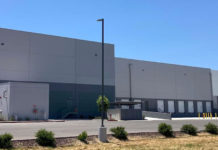Students at South Valley Junior High are part of the nation’s scientific movers and shakers.
With seismic and weather stations at the school, students have the opportunity to learn how to measure and monitor the gyrations of the earth or find out the dew point and wind speed on a given day.
Jan Froom, an SVJH parent, IBM employee and amateur seismographer, has lent some seismographs to the school, which students use to monitor the earth’s movement.
“I think it’s really fun,” said sixth grader Robin Rauss. “You get to come in and work on computers.”
Rauss and a group of students went to San Francisco late last year to the American Geological Union Convention.
“They were almost one of the hits of the groups up there,” Froom said.
Froom Is part of the Public Seismic Network, a group of amateur seismographers who monitor the earth’s movement, mainly in well-populated areas. Most seismographs are hidden away in the mountains or in mine shafts.
“They’d like to get more seismographs out in the areas where people live,” Froom said.
The PSN is working with the United States Geological Survey, and provides a very valuable service, according to Ed Cranswick of the USGS In Colorado.
“The great advantage is these people are a bunch of specialists,” he said. “They can serve to help USGS by representing seismography to the public, and performing an outreach to communities that we don’t have the people to do.”
SVJH houses vertical and horizontal professional seismographs, which measure the ground’s movement up and down and from side to side. It also has a homemade device.
“The amateur ones are as accurate as the professional ones,” Froom said. “They (the professional seismographs) are antiques now. Those are from the 1920s and 30s.”
Students use the output, of the seismographs, which, .are hooked to a computer and send their data there, to determjne the Magnitude of the ealth-quake and how far away it.was. They are also learning hori, to read and understand the
• machine’s output.
Sometimes, the results,The students get are right on target with what seismologists at, the University of California ‘get. Other times, they are a little bit off.
“None of it’s perfect,” Froom said. “It’s their best judgment. That’s the real end of science.”
Froom is also demystifying the mechanics of the seismic and weather stations for the students.
“The science behind this -is real simple,” he said. “It’s basically a magnet and a coil. There isn’t anything mind-boggling about it.”
The weather station, whidi is attached to a pole outside the computer lab, cost the schtkil about $2,000, which the patent club helped raise, and the ,seUl-mic station is on loan fibm Froom’s personal belongings:,’
Froom also said that the’sei9-mic and weather stations. can help teachers because they fit Into what the students learn in class anyway. The students•can also have a customized weather page for their classroom on the Internet.
“The main idea was to try provide something to help. the teachers,” he said.
Froom was one of 5th’s founders of the PSN, a grptip that is helping to spread the word about earthquakes and earthquake preparations, Cranswick said.
“It makes people aware, that earthquakes are part of the itot-mat healthy process,” he said.














